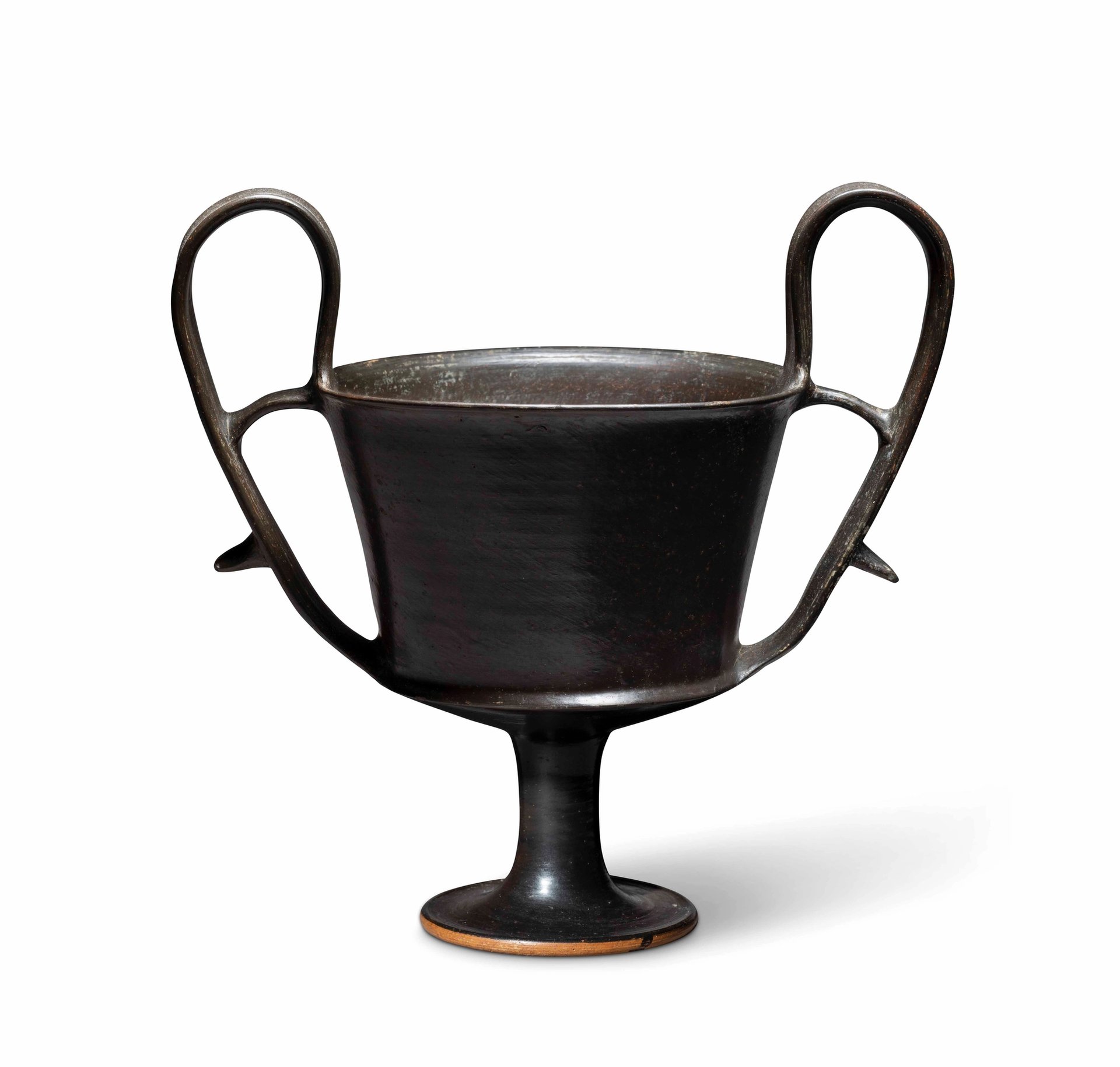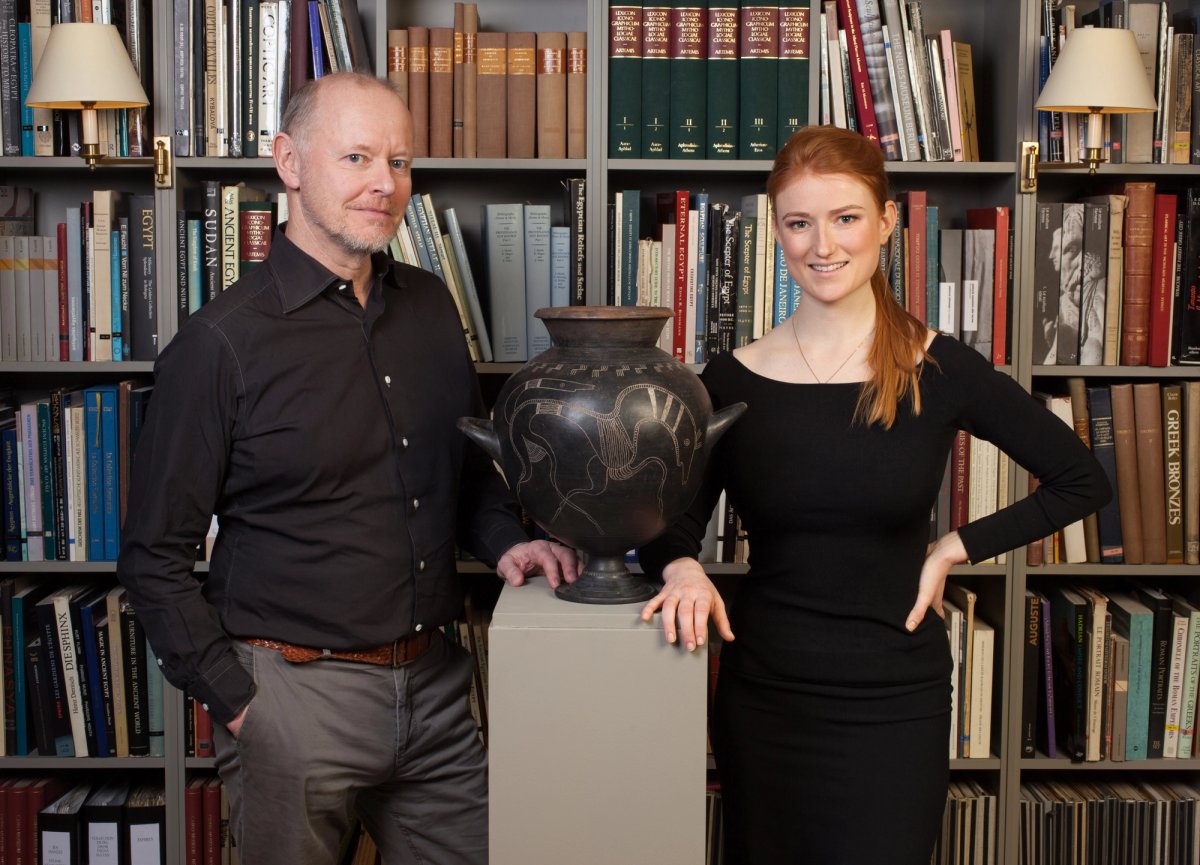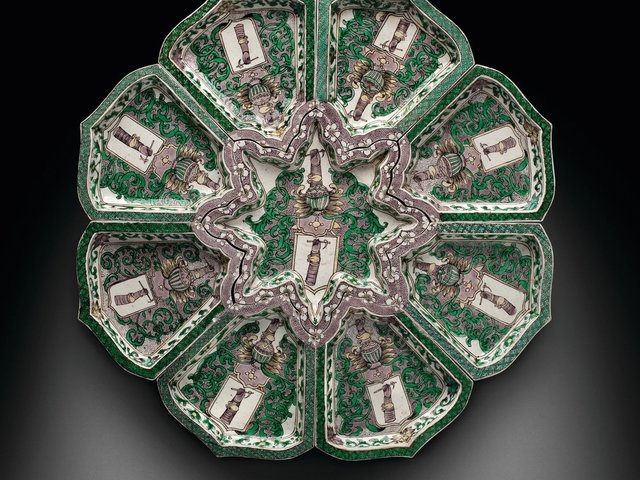Being a dealer in antiquities today is a very different prospect to that of 50 years ago.
When Charles Ede sold his companies, the Folio Society and Folio Fine Art, to open his own gallery dealing in antiquities at 37 Brook Street in Mayfair, London, in 1971, there was nowhere near the scrutiny that exists today, with media reports of the black market in looted objects sullying the legitimate trade too, dealers say.
Ede was a diligent record-keeper, and the gallery, which has been under the control of director Charis Tyndall and managing director Martin Clist since 2014, still has stock books dating back to the 1960s, recording all of the 30,000-plus works of art it has sold over five decades. “It wasn't until 1998 that we actually started using Excel," Tyndall says.
This week, the gallery marks its 50th anniversary with an exhibition of Greek Black Glaze pottery (12-29 October at 1 Three Kings' Yard, London). In the introduction to the catalogue, Charles Ede's son Jamie—who started working for his father in 1974 after an “inglorious stint” in the army—recounts how his father's interest in antiquities began: “In the spring of 1959 my father was walking down Cecil Court and saw an attractive pottery dish in the window of a dealer, marked ‘Roman terra-sigillata bowl, 1st century AD, 15/-’ (fifteen shillings in pre-decimal currency; 75p today). The shopkeeper was most indignant when asked if it was a copy, replying that all his antiquities were genuine.”
Over Zoom, Tyndall tells how Jamie’s first day working for his father nearly ended in disaster: “He nearly got fired on his very first day, because he went to buy cigarettes on his way and arrived about an hour and a half late. His father said, ‘you do that again, and you're out of here’.” He did not, and they ended up working together until Charles’s death in 2002.
Greek Black Glaze pottery was one of Ede’s favourite specialisms, Clist says: “It has an academic edge for which we are quite well-known. I doubt that it's going to be an amazing commercial success, but that’s not really why we’re doing it. It's to fulfil a long-held urge. It’s very fine pottery, and the glaze really makes you focus on the form. It's an extremely intriguing, low-key area of the market.”

A Greek black-glaze askos in the form of a boar, South Italy, around 320-290 BC, which will be included in the exhibition
Courtesy of Charles Ede
Clist and Tyndall, a generation apart in age, make an affable combination and they have brought a fresh viewpoint to this most traditional of galleries. Clist’s background is “very much rooted in contemporary art”—he did his postgraduate at the Slade in painting, then worked at the Whitechapel Gallery, for Leslie Waddington, then Karsten Schubert before, “through happenstance”, working for the antiquities dealer Rupert Wace for 17 years. When at the Whitechapel Gallery, Nick Serota taught Clist how to arrange works of art within a space. “I haven't come from the academic side of the Greek, Roman or the Egyptian world, but I've been able to bring in some of the things I learned from Nick about how objects need space. So we are entirely different to some of the more old-school antiquities dealers with glass cabinets, packed full of stuff. I like things to have enough space to resonate.” Tyndall is “much more rooted in the academic side, she has far deeper knowledge,” Clist says. “The marriage of those two things together is very important.”
As mentioned, the trade is now held to far higher standards with regards to provenance than it once was. Like all antiquities dealers, this is in the forefront of Tyndall and Clist’s minds, and they occasionally find themselves under fire. “It's just such nonsense that they constantly feed out this figure that the illegal market in antiquities is worth $10bn [a figure released by Unesco in 2020)—it's absolutely insupportable because the legitimate market can only come up with a fraction of that number, and it is inconceivable that there is an illegal market that's stronger than the legal market. It makes no sense.” Provenance “is a big conversation”, Clist says. “Sometimes we're somewhat stumped as, even though we’ve got these marvellous records, an entry for an object might just say ‘bought from Mr. Jones in 1972’. Back then, Charles Ede wasn't asking Mr. Jones if he could tell him more about the provenance, those questions were not asked by dealers until the very end of the 20th century, particularly when some of these items were very inexpensive, under £100.”
Tyndall adds that there is now an immediate suspicion among some: “It's an odd concept, because people come onto your stand at a fair and challenge what an object’s provenance is and whether it's legally on the market. I hope, with time, people are going to realise that as legitimate dealers, it should be a given that what we've got is going to be from a good source and is authentic.”
As Clist adds: “In the past, the art market was based on gentlemen's agreements, done on a handshake. The vendor would say ‘it was in a collection prior to 1980s’ and I don't think a lot more was asked. But now we are constantly asking questions of people, and of the objects that that get brought in. You’re often offered things over the internet or by email and the person will just say ‘my grandfather bought it’, which isn’t really good enough.”

Greek black-glaze kantharos, Boeotia, 5th century BC
Courtesy of Charles Ede
One issue is that a lot of people do not keep receipts, particularly for works of art and antiquities, Clist says: “Unlike paintings—which will have labels on the back as a record of where they've been exhibited and have collection marks and so on—antiquities, particularly a lot of small sculptures, they will lose elements such as the dealer’s stock number.”
Some of the time, a dealer has to go with their gut, judge how plausible a vendor’s provenance sounds: “Sometimes you just know that what they're telling you is not right,” Clist says. “There might be enough evidence in one way, but it's just not convincing. Very often, that's because it’s a provenance which has been deliberately made up by somebody.” The gallery will alert the police when they are suspicious about a piece: “We'll let them know that we've being offered something which we feel is not right. Occasionally we've helped repatriate works which should be in museum storerooms and they have got out into the market.” The art and antiques division at Scotland Yard will also approach them on occasion, to ask if certain individuals have been in touch: “We have a very free dialogue with that side of the law enforcement, because none of us want to be caught out.”
One of the more unpleasant sides of the business now, Clist says, is that there is “an idea prevalent that dealers are complicit—like James Bond villains, organising this strange, illicit world. And it's not like that at all.”
In fact sometimes, the gallery is able to “give an item back its provenance” or make new connections. “A few years ago, we found a small fragment of an Egyptian wooden box, which we bought from a dealer at Tefaf Maastricht,” Clist says. “I was then talking to an Egyptologist, who said, I think you ought to get in contact with the National Museums Scotland, because I think this comes from one of their most important Egyptian pieces. To cut a long story short, it did—it was part of a box that belonged to one of the pharoah’s wives…it felt very good that we had been able to put these two pieces back together.”
This fragment was bought with the provenance “private collection, Germany, acquired circa 1965”. Tyndall says: “It's amazing how this information gets lost. And so being able to track back its provenance back another 100 years and reunite it with the rest of the box was really thrilling.”
Although prices are often lower than you would expect, antiquities is a complex field, so what advice would they give to aspiring collectors? Do your research, Clist says, and do not just look on the internet and buy something off eBay: “You need to work out who are the reputable dealers. And there are ways of doing that on the internet, you can find out who belongs to the appropriate organisations—for example, we belong to the IADAA [International Association of Dealers in Ancient Art], the ADA [Antiquities Dealers' Association] and BADA [British Antiques Dealers Association]. Find a dealer who has their head well above the parapet—publishing catalogues, doing art fairs, with a good website etc.”
And, Tyndall adds: “Buy something because you love it, not just because you can afford it. Some antiquities are incredibly inexpensive, but that should not be a reason to buy something. Decide what you absolutely love, and then work out if it's within your price bracket.”
- Greek Black Glaze, 12-29 October, Charles Ede, 1 Three Kings' Yard, London




